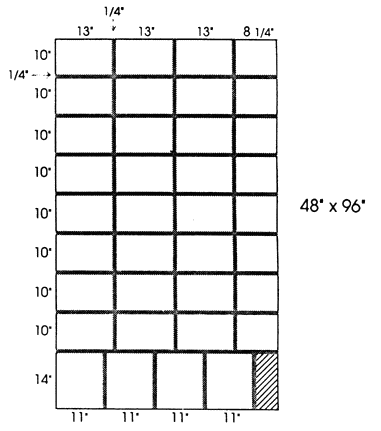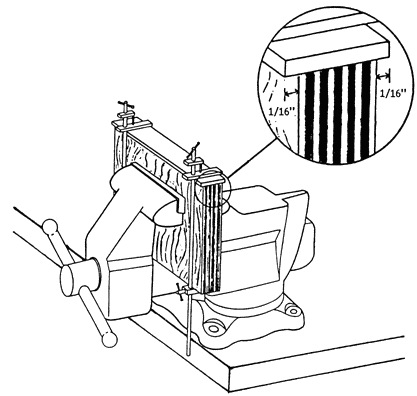

When repairing circulating materials in the Conservation Department, it seems that we never have enough brass-edged boards. Many of our repairs involve tightening hinges or recasing, which in our production facility requires numerous press boards. After much consideration we decided to construct the press boards ourselves instead of purchasing them from commercial sources. This enabled us to keep our costs down and ensured a high quality product.
In addition, we prepared plain boards of different sizes. These boards are useful as weights for flattening materials and for supporting textblocks while doing page repair.
Making our own press boards gives us the opportunity to decide on any size board that fits our needs. The sizes were chosen to fit both the dimensions of books we mend and our Vagelli press, which has a platen 19½" x 15½". The two most important considerations are 1) choosing a good quality wood that does not splinter or warp and 2) making sure the brass is centered on the edge of the board, resulting in an even pressure when pressing books. We chose to leave the boards unfinished to reduce the risk of varnish blocking and to keep costs down. Any dirt can be sanded off.
What follows are instructions for construction of press boards in these sizes and quantities:
| 14" x 11" | 8 plain boards |
| 13" x 10" | 20 brass-edged boards 28 plain boards |
| 10" x 8¼" | 16 plain boards |

| Wood: | 2 sheets 5/8" hardwood veneer plywood, top grade (4' x 8'), e.g. birch veneer. Purchase precut from lumberyard per diagram, allowing ¼" for the cuts, as indicated by grey area. |
| Brass stripping: | 3/4" x 1/16". Purchase precut if possible. |
| Brass wood screws: | Flathead #6, 3/4", 4 per board |
| Sandpaper: | 120 grade, several sheets |
| Electric sander - Radial saw - Electric drill - Bench vise | |
| Drill bits: | #6 Flathead screwdriver #6 Combination drill bit/countersink. Have 2 or 3 drill bits on hand. |
| Bar clamps: | 10" capacity, 2 clamps |
| Cost Of Materials | Time |
| $200, depending upon local costs | 5 hours planning 20 hours construction |
